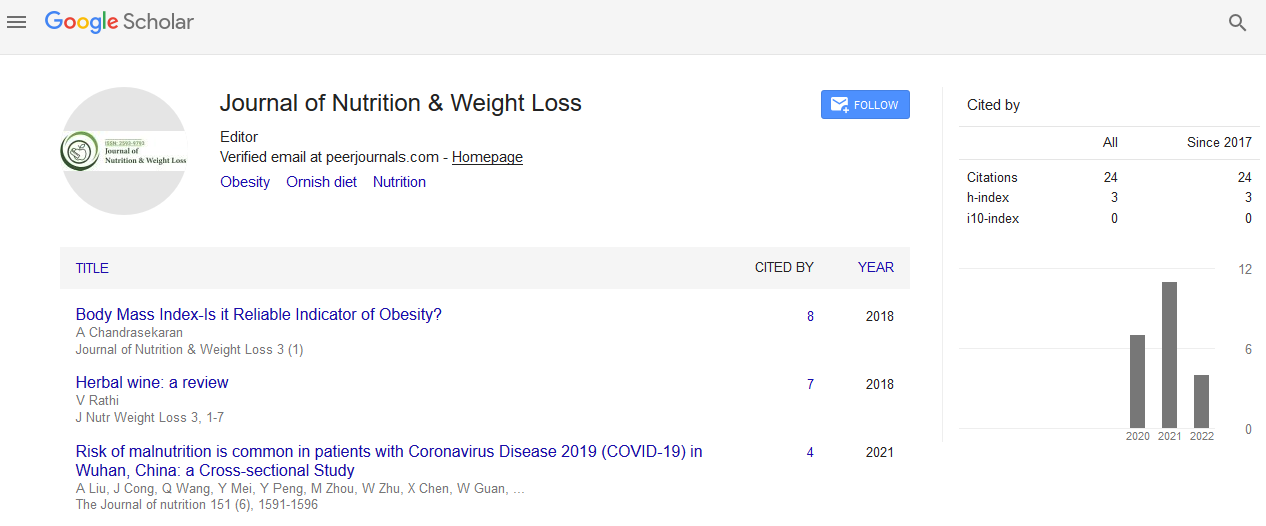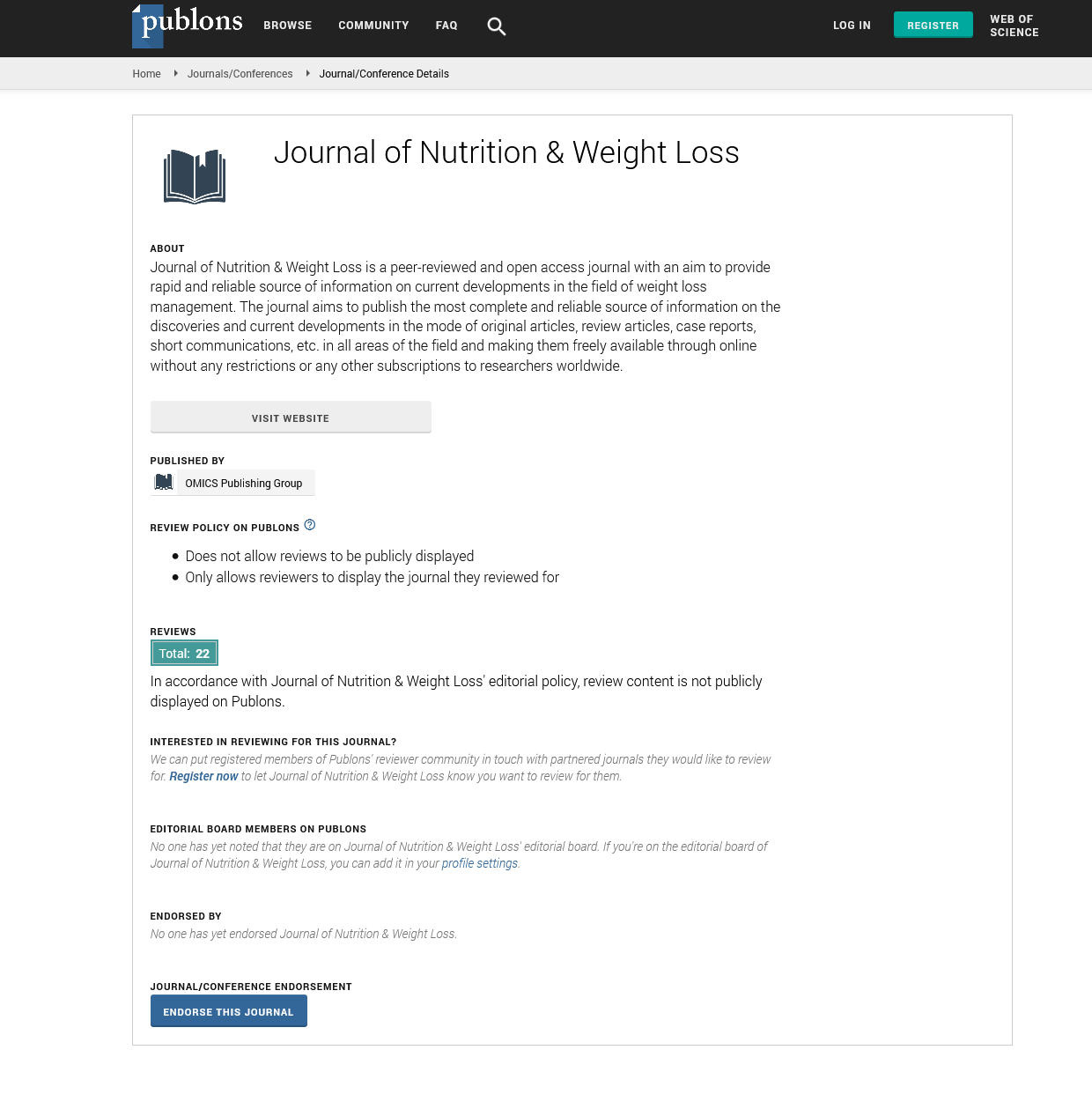Indexed In
- RefSeek
- Hamdard University
- EBSCO A-Z
- Publons
- Euro Pub
- Google Scholar
Useful Links
Share This Page
Journal Flyer

Open Access Journals
- Agri and Aquaculture
- Biochemistry
- Bioinformatics & Systems Biology
- Business & Management
- Chemistry
- Clinical Sciences
- Engineering
- Food & Nutrition
- General Science
- Genetics & Molecular Biology
- Immunology & Microbiology
- Medical Sciences
- Neuroscience & Psychology
- Nursing & Health Care
- Pharmaceutical Sciences
Perspective - (2024) Volume 9, Issue 1
Impact of Sphingosine-1-Phosphate on Appetite Regulation
Chai Anam*Received: 02-Mar-2024, Manuscript No. JNWL-24-26377; Editor assigned: 05-Mar-2024, Pre QC No. JNWL-24-26377 (PQ); Reviewed: 21-Mar-2024, QC No. JNWL-24-26377; Revised: 27-Mar-2024, Manuscript No. JNWL-24-26377 (R); Published: 05-Apr-2024, DOI: 10.35248/2593-9793.24.9.195
Description
The pathophysiology of Multiple Sclerosis (MS) may be explained by immune cell migration into the central nervous system. Peripheral auto-reactive T and B lymphocytes induce inflammation, demyelination, and neurodegeneration after going through the blood-brain barrier and entering the Central Nervous System (CNS), where they are activated by Antigen- Presenting Cells (APCs). This compound binds to the sphingosine-1-phosphate receptors on immune cells, causing the cells to become stuck in adjacent lymph nodes. This may lessen the immune cells' ability to migrate into the CNS tissue. Many adverse effects, including cardiac complications, rising blood pressure, elevated liver enzymes, fatigue, macular edema, leukopenia, and an increased risk of infection and malignancy, have been reported with S1p modulator medications.
Given that the hypothalamus expresses S1PRs in large quantities, fingolimod likely has a discernible effect on hypothalamic activities such as appetite and body weight. They were also asked if they have experienced any other side effects from using fingolimod. Patients who had previously taken fingolimod and reported changes in appetite conducted the necessary examinations. Additionally, SPSS 22.0 for windows was used to perform statistical analyses, and all data were displayed as mean, SD, percentage, and count for frequencies.
A loss of 4.5 kg, or 5% of body weight, over a period of 6 to 12 months is considered a clinically significant unintentional weight loss. More than 10% of body weight lost in six months or more than 20% during a twelve-month period is considered severe weight loss.
It was determined that there were no other plausible reasons for weight loss, such as cancer, gastrointestinal disorders, and mental health problems. Fingolimod-phosphate primarily affects Sphingosine 1-Phosphate Receptor 1 (S1PR1), out of the five known subtypes of S1PRs. However, it can also attach to S1PR3, S1PR4, and S1PR5. The main ways that fingolimod helps to manage multiple sclerosis are by preventing lymphocytes from leaving lymph nodes and by suppressing the S1P receptors on these cells. Fingolimod use, however, may also negatively impact other undesirable body functions, such those of the hypothalamus, considering the variety of tissues and cell types that express S1PRs. The Accurate Nucleus of the Hypothalamus (ARH) is located in the ventromedial area of the hypothalamus, near the median eminence.
Because the ARH is extensively supplied by fenestrated capillaries, it may therefore monitor metabolic and hormonal signals from the peripheral blood circulation and integrate them with brain impulses. In the accurate nuclei, anorexigenic neurons as opposed to orexigenic neurons express S1PR1 to a greater extent. S1PR was administered to the third ventricles of rats, and studies have indicated that this treatment can reduce appetite while raising body temperature and energy expenditure. Furthermore, there are no differences in the outcomes of intravascular and intraperitoneal S1P delivery.
An intraoral splint, which lowers oral capacity by 25% and modifies eating speed without stopping users from eating, is one innovative medical device that can affect eating habit. Six obese individuals with a high-risk cardiovascular profile participated in a prospective research to evaluate this device. They were given the device for four to eight weeks, during which time they lost a considerable amount of weight that lasted for two years.
The patients were instructed not to track calories or adhere to any particular diet, and the device was only to be used during meals. The intracellular part of S1PR1 is associated with two Janus kinase 2 (JAK2) proteins. Following S1PR's binding to S1PR1, JAK2 becomes phosphorylated, triggering the phosphorylation of Signal Transducer and Activator of Transcription 3 (STAT3), resulting in the formation of a homodyne. The effect of STAT3 homodyne on transcription factors and Promoters of Proopiomelanocortin (POMC) results in an increase in S1PR1 mRNA levels.
Citation: Anam C (2024) Impact of Sphingosine-1-Phosphate on Appetite Regulation. J Nutr Weight Loss. 9:195.
Copyright: © 2024 Anam C. This is an open access article distributed under the terms of the Creative Commons Attribution License, which permits unrestricted use, distribution, and reproduction in any medium, provided the original author and source are credited.


